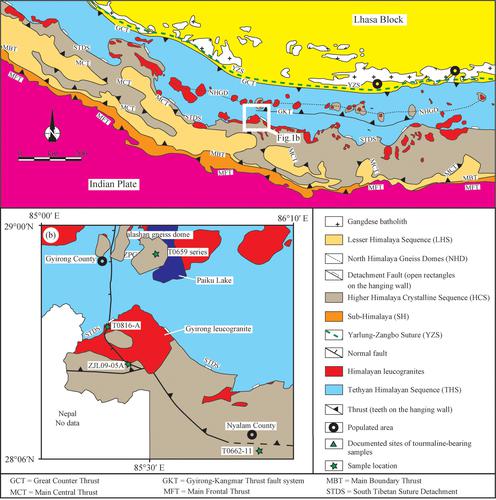当前位置:
X-MOL 学术
›
Acta Geol. Sinica Engl. Ed.
›
论文详情
Our official English website, www.x-mol.net, welcomes your feedback! (Note: you will need to create a separate account there.)
Geochemical and Boron Isotopic Evidence that Tourmaline Records Country Rock Assimilation of Leucogranites in the Himalayan Orogen
Acta Geologica Sinica-English Edition ( IF 3.3 ) Pub Date : 2021-08-11 , DOI: 10.1111/1755-6724.14800 Guyue HU 1 , Li'e GAO 1 , Lingsen ZENG 2 , Yike LI 1
Acta Geologica Sinica-English Edition ( IF 3.3 ) Pub Date : 2021-08-11 , DOI: 10.1111/1755-6724.14800 Guyue HU 1 , Li'e GAO 1 , Lingsen ZENG 2 , Yike LI 1
Affiliation

|
Tourmaline geochemical and boron (B) isotopic compositions in two-mica granites (TMG), tourmaline-bearing leucogranites (Tou-LG), tourmalites and metapelites from the Gyirong–Malashan areas of the Himalayan orogen provide evidence for country rock assimilation during the intrusion of Himalayan leucogranite. The schorls in Gyirong leucogranitic plutons show low contents of MgO (0.238%–1.160%) and δ11B values (–12.1‰––11.2‰), while dravites gathered in the contact zone between the leucogranitic veins and metapelites show high contents of MgO (4.815%–6.755%) and δ11B values (–10.7‰––9.3‰). This geochemical and isotopic variation of tourmalines can also be identified in the Malashan gneiss dome. As a result, three types of tourmaline were identified in the Himalayan orogen: (1) Tou-I in the TMG and Tou-LG, which is the most common tourmaline type of schorl; (2) Tou-II (dravite and high-Mg schorl) in the Tou-LG and tourmalite at the margins of the leucogranite; and (3) Tou-III (mainly dravite, with minor high-Mg schorl) in metapelites of the High Himalayan Crystalline Sequence. The lenses and veins of Tou-LG may have experienced metasomatism and assimilation as a result of interaction with the High Himalayan Crystalline Sequence metasedimentary country rocks, which can be traced by the geochemical and isotopic characteristics of the tourmaline therein.
中文翻译:

电气石记录喜马拉雅造山带浅色花岗岩乡村岩石同化的地球化学和硼同位素证据
喜马拉雅造山带 Gyirong-Malashan 地区的双云母花岗岩 (TMG)、含电气石的淡色花岗岩 (Tou-LG)、电气石和变泥岩中的电气石地球化学和硼 (B) 同位素组成为侵入过程中的围岩同化提供了证据喜马拉雅无色花岗岩。Gyirong 淡色花岗质岩体中的 schols MgO 含量较低(0.238%~1.160%),δ 11 B 值较低(–12.1‰ ~ –11.2‰),而聚集在淡色花岗质岩脉与变泥质岩接触带的砂砾岩含量较高。 MgO (4.815%–6.755%) 和δ 11 B 值 (–10.7‰ ––9.3‰)。这种电气石的地球化学和同位素变化也可以在马拉山片麻岩圆顶中发现。结果,在喜马拉雅造山带中确定了三种类型的电气石:(1)TMG中的Tou-I和Tou-LG,这是最常见的电气石类型。(2) Tou-LG 中的 Tou-II (dravite and high-Mg schorl) 和浅色花岗岩边缘的电气石;(3) 高喜马拉雅结晶序列的变泥质岩中的 Tou-III(主要是镁砂,少量高镁 schorl)。Tou-LG的透镜体和矿脉可能由于与高喜马拉雅结晶层序变沉积围岩相互作用而发生了交代和同化作用,这可以通过其中电气石的地球化学和同位素特征来追踪。
更新日期:2021-08-11
中文翻译:

电气石记录喜马拉雅造山带浅色花岗岩乡村岩石同化的地球化学和硼同位素证据
喜马拉雅造山带 Gyirong-Malashan 地区的双云母花岗岩 (TMG)、含电气石的淡色花岗岩 (Tou-LG)、电气石和变泥岩中的电气石地球化学和硼 (B) 同位素组成为侵入过程中的围岩同化提供了证据喜马拉雅无色花岗岩。Gyirong 淡色花岗质岩体中的 schols MgO 含量较低(0.238%~1.160%),δ 11 B 值较低(–12.1‰ ~ –11.2‰),而聚集在淡色花岗质岩脉与变泥质岩接触带的砂砾岩含量较高。 MgO (4.815%–6.755%) 和δ 11 B 值 (–10.7‰ ––9.3‰)。这种电气石的地球化学和同位素变化也可以在马拉山片麻岩圆顶中发现。结果,在喜马拉雅造山带中确定了三种类型的电气石:(1)TMG中的Tou-I和Tou-LG,这是最常见的电气石类型。(2) Tou-LG 中的 Tou-II (dravite and high-Mg schorl) 和浅色花岗岩边缘的电气石;(3) 高喜马拉雅结晶序列的变泥质岩中的 Tou-III(主要是镁砂,少量高镁 schorl)。Tou-LG的透镜体和矿脉可能由于与高喜马拉雅结晶层序变沉积围岩相互作用而发生了交代和同化作用,这可以通过其中电气石的地球化学和同位素特征来追踪。



























 京公网安备 11010802027423号
京公网安备 11010802027423号